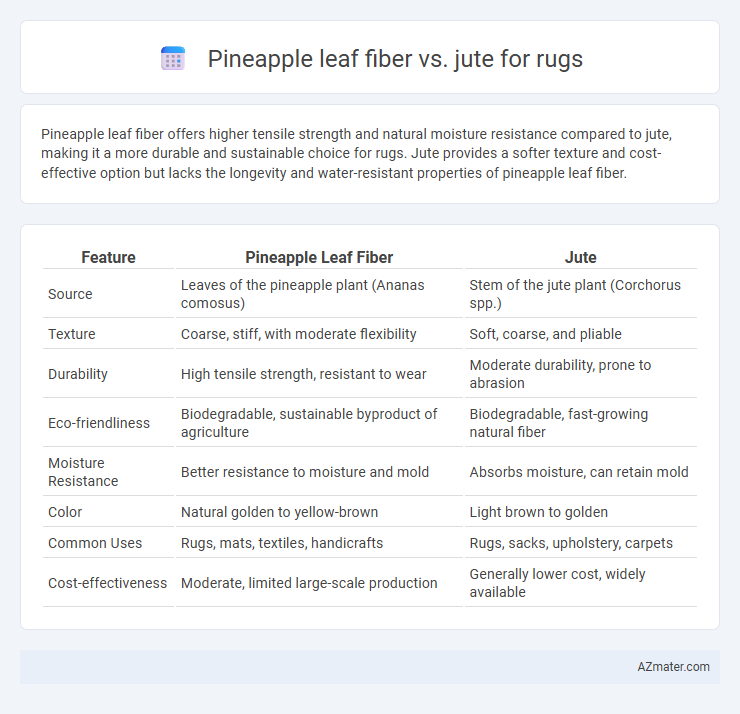Pineapple leaf fiber offers higher tensile strength and natural moisture resistance compared to jute, making it a more durable and sustainable choice for rugs. Jute provides a softer texture and cost-effective option but lacks the longevity and water-resistant properties of pineapple leaf fiber.
Table of Comparison
| Feature | Pineapple Leaf Fiber | Jute |
|---|---|---|
| Source | Leaves of the pineapple plant (Ananas comosus) | Stem of the jute plant (Corchorus spp.) |
| Texture | Coarse, stiff, with moderate flexibility | Soft, coarse, and pliable |
| Durability | High tensile strength, resistant to wear | Moderate durability, prone to abrasion |
| Eco-friendliness | Biodegradable, sustainable byproduct of agriculture | Biodegradable, fast-growing natural fiber |
| Moisture Resistance | Better resistance to moisture and mold | Absorbs moisture, can retain mold |
| Color | Natural golden to yellow-brown | Light brown to golden |
| Common Uses | Rugs, mats, textiles, handicrafts | Rugs, sacks, upholstery, carpets |
| Cost-effectiveness | Moderate, limited large-scale production | Generally lower cost, widely available |
Introduction to Pineapple Leaf Fiber and Jute
Pineapple leaf fiber, extracted from the leaves of the pineapple plant, is a sustainable and durable natural fiber increasingly used in rug production due to its strength and eco-friendly properties. Jute, known as the "golden fiber," is a long, soft, and shiny vegetable fiber primarily grown in India and Bangladesh, widely favored for its affordability and natural texture in rug manufacturing. Both fibers offer biodegradability and a unique aesthetic, but pineapple leaf fiber stands out for its higher tensile strength and resistance to wear.
Botanical Origins and Sustainability
Pineapple leaf fiber, derived from the leaves of the Ananas comosus plant, offers a sustainable alternative to jute, which comes from the Corchorus species. Both fibers are biodegradable and renewable, but pineapple leaf fiber utilizes agricultural waste, reducing resource consumption and enhancing eco-friendliness. Jute requires significant water and pesticide inputs, making pineapple leaf fiber a preferable choice for environmentally conscious rug production.
Harvesting and Processing Methods
Pineapple leaf fiber, derived from renewable pineapple leaves, involves manual harvesting followed by mechanical decortication to extract long, strong fibers ideal for durable rugs. Jute, sourced from the stem of the Corchorus plant, undergoes retting--a microbial process that separates fibers by soaking--to produce soft and flexible strands commonly used in rug making. Pineapple fiber's eco-friendly extraction minimizes water usage, whereas jute's traditional retting demands substantial water and time, influencing sustainability and production efficiency.
Fiber Strength and Durability Comparison
Pineapple leaf fiber exhibits higher tensile strength compared to jute, making it a more robust option for rugs subject to heavy foot traffic. Its natural cellulose structure enhances durability and resistance to wear over time, outperforming jute in maintaining integrity under stress. Jute offers moderate durability but tends to degrade faster in humid environments, whereas pineapple leaf fiber's resilience extends rug lifespan in diverse conditions.
Texture and Appearance in Rugs
Pineapple leaf fiber offers a coarse yet smooth texture, providing a natural sheen and a subtle, lustrous appearance in rugs that enhances aesthetic appeal. Jute fibers present a slightly rougher texture with a matte finish, creating a rustic and earthy look ideal for casual and traditional rug designs. Both fibers are durable, but pineapple leaf fiber tends to produce a finer weave, resulting in more intricate patterns and a polished appearance compared to jute.
Environmental Impact and Eco-friendliness
Pineapple leaf fiber is a sustainable alternative to jute, as it utilizes agricultural waste and reduces deforestation compared to traditional jute cultivation. Both fibers are biodegradable, but pineapple leaf fiber offers a lower water footprint and requires fewer pesticides, enhancing its eco-friendliness. Pineapple fiber rugs contribute to waste reduction and promote circular economy practices, making them environmentally favorable over jute in rug production.
Cost and Market Availability
Pineapple leaf fiber offers a higher cost compared to jute, driven by its limited production scale and complex extraction process, making it a premium choice for rugs. Jute remains more cost-effective due to widespread cultivation and established global supply chains, ensuring greater market availability. Consumers seeking affordable and readily accessible rug materials typically prefer jute, while niche markets favor pineapple leaf fiber for its durability and eco-friendly appeal despite higher pricing.
Maintenance and Longevity of Rugs
Pineapple leaf fiber rugs exhibit exceptional durability and resistance to wear, making them ideal for high-traffic areas, with low maintenance requirements due to their natural antifungal properties. Jute rugs, while softer and more affordable, tend to absorb moisture easily, leading to quicker deterioration and demanding more frequent cleaning and careful handling to extend their lifespan. Both fibers require regular vacuuming, but pineapple leaf fiber rugs generally offer longer longevity and better moisture resistance than jute counterparts.
Applications Beyond Rugs
Pineapple leaf fiber offers superior strength, durability, and moisture resistance compared to jute, making it ideal for eco-friendly textiles and composite materials beyond rug applications. Its fine texture and natural sheen enable usage in fashion, upholstery, and automotive interiors, whereas jute is primarily used in packaging, geotextiles, and low-cost home decor. Innovations in pineapple leaf fiber processing enhance biodegradability and sustainability, expanding its potential in diverse industries seeking renewable alternatives.
Choosing the Right Fiber for Your Needs
Pineapple leaf fiber offers superior durability and a smoother texture compared to jute, making it ideal for high-traffic areas and luxurious rug finishes. Jute fibers provide a more affordable, biodegradable option with a rustic appearance, suitable for casual or eco-friendly interiors. Evaluating factors such as durability, texture, and environmental impact will help determine the best fiber choice for your rug's functionality and aesthetic.

Infographic: Pineapple leaf fiber vs Jute for Rug
 azmater.com
azmater.com